常用测量程序设计
(1)用全站仪在 A 点观测了 B 点斜边和垂直角,求 A 到 B 的高差。
a i
,D--斜边,a--垂直角,i --仪器高,v --反
v
(提示:
h
AB
D
sin
a
(1
k
)
2
D
2
R
2
cos
光镜高, k --大气折光系数)
using System;
using System.Collections.Generic;
using System.Text;
namespace ConsoleApplication1
{
class Application
{
static void Main(string[] args)
{
Console.Write("请输入斜边=");
double D = double.Parse(Console.ReadLine());
Console.Write("请输入垂直角[ddd.mmss]=");
double a = DEG(double.Parse(Console.ReadLine()));
Console.Write("请输入仪器高=");
double i = double.Parse(Console.ReadLine());
Console.Write("请输入反光镜高=");
double v = double.Parse(Console.ReadLine());
double h = D * Math.Sin(a) + (1 - 0.13) * D / 6371000.0 * D / 6371000.0 * Math.Cos(a)
* Math.Cos(a) / 2.0 + i - v;
Console.WriteLine("高差为{0}",h);
}
//将ddd.mmss转为弧度
static public double DEG(double ang)
int fuhao = (int)(ang / Math.Abs(ang));
ang = Math.Abs(ang);
int d = (int)ang;
int m = ((int)(ang * 100)) - d * 100;
double s = ang * 10000 - m * 100 - d * 10000;
return ((d + m / 60.0 + s / 3600.0) * fuhao) / 180.0 * Math.PI;
{
}
}
}
�
(2)如图所示,已知 A 点的坐标及 A 点到 B 点的边长及方位角,计算 B 点的坐标。
using System;
using System.Collections.Generic;
using System.Text;
namespace ConsoleApplication1
{
class Application
{
static void Main(string[] args)
{
}
Console.Write("请输入A点的X坐标=");
double XA = double.Parse(Console.ReadLine());
Console.Write("请输入A点的Y坐标=");
double YA = double.Parse(Console.ReadLine());
Console.Write("请输入A到B的方位角[ddd.mmss]=");
double a = DEG(double.Parse(Console.ReadLine()));
Console.Write("请输入A到B的水平距离=");
double S = double.Parse(Console.ReadLine());
double XB = XA + S*Math.Cos(a);
double YB = YA + S*Math.Sin(a);
Console.WriteLine("B点的坐标({0},{1})",XB,YB);
//将ddd.mmss转为弧度
static public double DEG(double ang)
int fuhao = (int)(ang / Math.Abs(ang));
ang = Math.Abs(ang);
int d = (int)ang;
int m = ((int)(ang * 100)) - d * 100;
double s = ang * 10000 - m * 100 - d * 10000;
return ((d + m / 60.0 + s / 3600.0) * fuhao) / 180.0 * Math.PI;
{
}
}
}
(3)如图所示,已知 A 点和 B 点的坐标,计算 A 点到的边长及方位角。
using System;
using System.Collections.Generic;
using System.Text;
namespace ConsoleApplication1
{
class Application
{
�
static void Main(string[] args)
{
}
Console.Write("请输入A点的X坐标=");
double XA = double.Parse(Console.ReadLine());
Console.Write("请输入A点的Y坐标=");
double YA = double.Parse(Console.ReadLine());
Console.Write("请输入B点的X坐标=");
double XB = double.Parse(Console.ReadLine());
Console.Write("请输入B点的Y坐标=");
double YB = double.Parse(Console.ReadLine());
double S = 距离(XA, YA, XB, YB);
double a = 方位角(XA, YA, XB, YB);
Console.WriteLine("AB间的距离={0},从A到B的方位角={1}",S,DMS(a));
//将弧度转为ddd.mmss
static public double DMS(double ang)
{
}
ang += 1.0E-15;//加上一个小量,以保证进位
int fuhao = (int)(ang / Math.Abs(ang));
ang = Math.Abs(ang) * 180.0 / Math.PI;
int d = (int)ang;
ang = (ang - d) * 60.0;
int m = (int)ang;
double s = (ang - m) * 60.0;
return (d + m / 100.0 + s / 10000.0) * fuhao;
//计算方位角,返回弧度值
public static double 方位角(double x1, double y1, double x2, double y2)
{
double deltaX = x2 - x1;
double deltaY = y2 - y1;
double angle = Math.PI * 0.5;
if (Math.Abs(deltaX) > 0.000000001)
{
}
angle = Math.Atan2(deltaY, deltaX);
if (angle < 0)
{
}
angle += Math.PI;
if (deltaY < 0.0)
{
}
angle += Math.PI;
�
return angle;
}
//计算距离
public static double 距离(double x1, double y1, double x2, double y2)
return Math.Sqrt((x2 - x1) * (x2 - x1) + (y2 - y1) * (y2 - y1));
{
}
}
}
(4)在如图所示的支中导线,已知 A 点到 M 点的坐标方位角 0a 及每个左角,求每条边的
坐标方位角。
using System;
using System.Collections.Generic;
using System.Text;
namespace ConsoleApplication1
{
class Application
{
static void Main(string[] args)
{
Console.Write("请输入A点到M点的坐标方位角=");
//将A点到M点的坐标方位角换算为M点到A点的坐标方位角,以便利用公式
double a0 = DEG(double.Parse(Console.ReadLine()) +180.0);
if (a0 > 2 * Math.PI)
{
}
a0 -= 2 * Math.PI;
List 导线转角集合 = new List();
int i = 1;
do
{
Console.Write("请输入第{0}个转角的水平角[左角为正,右角为负] <直接回车结束输
入>=",i++);
string str = Console.ReadLine();
�
if (str != "")
{
}
导线转角集合.Add(DEG(double.Parse(str)));
else
{
}
break;
} while (true);
i = 1;
foreach (double a in 导线转角集合)
{
a0 += a + Math.PI;
if (a0 > 2 * Math.PI)
{
}
a0 -= 2 * Math.PI;
else if (a0 < 0.0)
{
}
a0 += 2 * Math.PI;
Console.WriteLine("第{0}条边的方位角为{1}",i++,DMS(a0));
}
}
//将弧度转为ddd.mmss
static public double DMS(double ang)
{
}
ang += 1.0E-15;//加上一个小量,以保证进位
int fuhao = (int)(ang / Math.Abs(ang));
ang = Math.Abs(ang) * 180.0 / Math.PI;
int d = (int)ang;
ang = (ang - d) * 60.0;
int m = (int)ang;
double s = (ang - m) * 60.0;
return (d + m / 100.0 + s / 10000.0) * fuhao;
//将ddd.mmss转为弧度
static public double DEG(double ang)
{
int fuhao = (int)(ang / Math.Abs(ang));
ang = Math.Abs(ang);
int d = (int)ang;
int m = ((int)(ang * 100)) - d * 100;
double s = ang * 10000 - m * 100 - d * 10000;
�
return ((d + m / 60.0 + s / 3600.0) * fuhao) / 180.0 * Math.PI;
}
}
}
(5)在如图所示的支中导线,已知 A 点和 M 点的坐标及每个左角和每条边长,求每个点的
坐标。
using System;
using System.Collections.Generic;
using System.Text;
namespace ConsoleApplication1
{
class Application
{
static void Main(string[] args)
{
Console.Write("请输入M点的x坐标=");
double Mx = double.Parse(Console.ReadLine());
Console.Write("请输入M点的y坐标=");
double My = double.Parse(Console.ReadLine());
Console.Write("请输入A点的x坐标=");
double Ax = double.Parse(Console.ReadLine());
Console.Write("请输入A点的y坐标=");
double Ay = double.Parse(Console.ReadLine());
List 导线转角集合 = new List();
List 导线边长集合 = new List();
int i = 1;
do
{
Console.Write("请输入第{0}个转角的水平角[左角为正,右角为负]<直接回车结束输
入>=",i);
string str = Console.ReadLine();
if (str != "")
{
导线转角集合.Add(DEG(double.Parse(str)));
�
}
else
{
}
break;
Console.Write("请输入第{0}条边长值=", i++);
导线边长集合.Add( double.Parse(Console.ReadLine()));
} while (true);
//计算M到A的坐标方位角
double a0 = 方位角(Mx, My, Ax, Ay);
//计算每个点的坐标
double x0 = Ax;
double y0 = Ay;
for (int j = 0; j < 导线转角集合.Count; j++)
{
}
a0 += 导线转角集合[j] + Math.PI;
if (a0 > 2 * Math.PI) a0 -= 2 * Math.PI;
x0 = x0 + 导线边长集合[j] * Math.Cos(a0);
y0 = y0 + 导线边长集合[j] * Math.Sin(a0);
Console.WriteLine("P{0}点的坐标是:{1},{2}",j+2,x0,y0);
}
//将ddd.mmss转为弧度
static public double DEG(double ang)
{
}
int fuhao = (int)(ang / Math.Abs(ang));
ang = Math.Abs(ang);
int d = (int)ang;
int m = ((int)(ang * 100)) - d * 100;
double s = ang * 10000 - m * 100 - d * 10000;
return ((d + m / 60.0 + s / 3600.0) * fuhao) / 180.0 * Math.PI;
//计算方位角,返回弧度值
public static double 方位角(double x1, double y1, double x2, double y2)
{
double deltaX = x2 - x1;
double deltaY = y2 - y1;
double angle = Math.PI * 0.5;
if (Math.Abs(deltaX) > 0.000000001)
{
}
angle = Math.Atan2(deltaY, deltaX);
if (angle < 0)
{
�
angle += Math.PI;
}
if (deltaY < 0.0)
{
}
angle += Math.PI;
return angle;
}
}
}
(6)在如图所示的单一附合水准路线中,已知 A 点和 B 点的高程及每段的长度和高差,求
每个点的高程。
using System;
using System.Collections.Generic;
using System.Text;
namespace ConsoleApplication1
{
class Application
{
static void Main(string[] args)
{
Console.Write("请输入A点的高程=");
double Ha = double.Parse(Console.ReadLine());
Console.Write("请输入B点的高程=");
double Hb = double.Parse(Console.ReadLine());
List 路线段长度集合 = new List();
List 路线段高差集合 = new List();
int i = 1;
do
{
Console.Write("请输入第{0}段长度[公里为单位]<直接回车结束输入>=",i);
string str = Console.ReadLine();
if (str != "")
{
}
路线段长度集合.Add(double.Parse(str));
else
{
break;
�
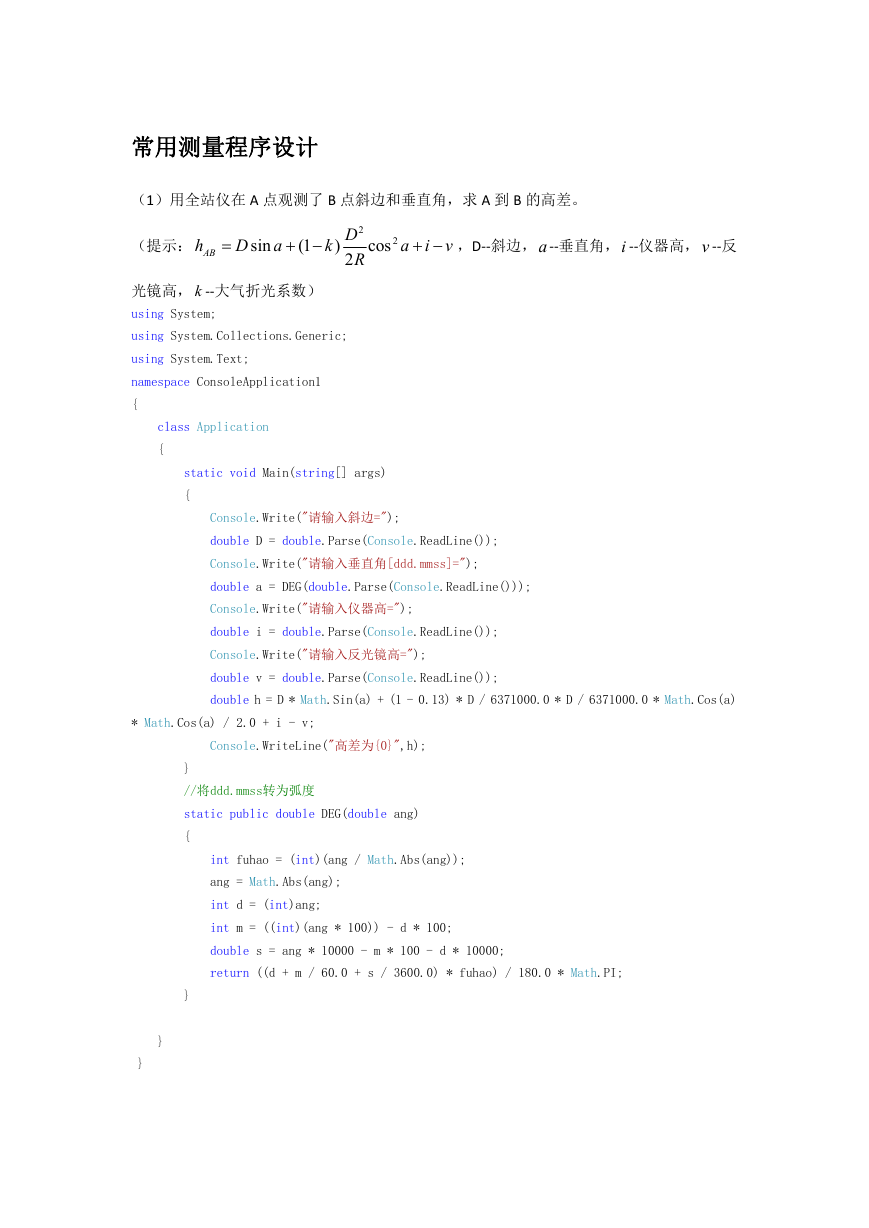
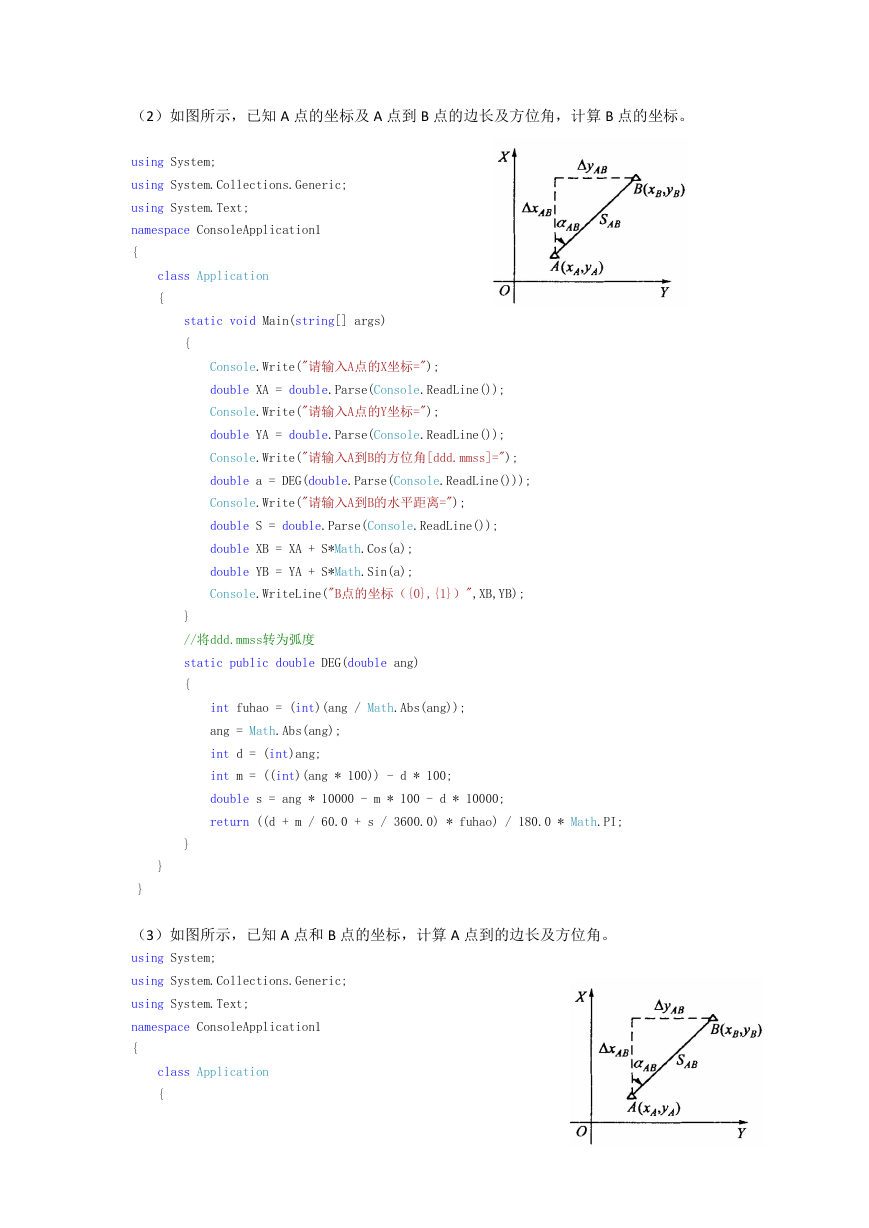
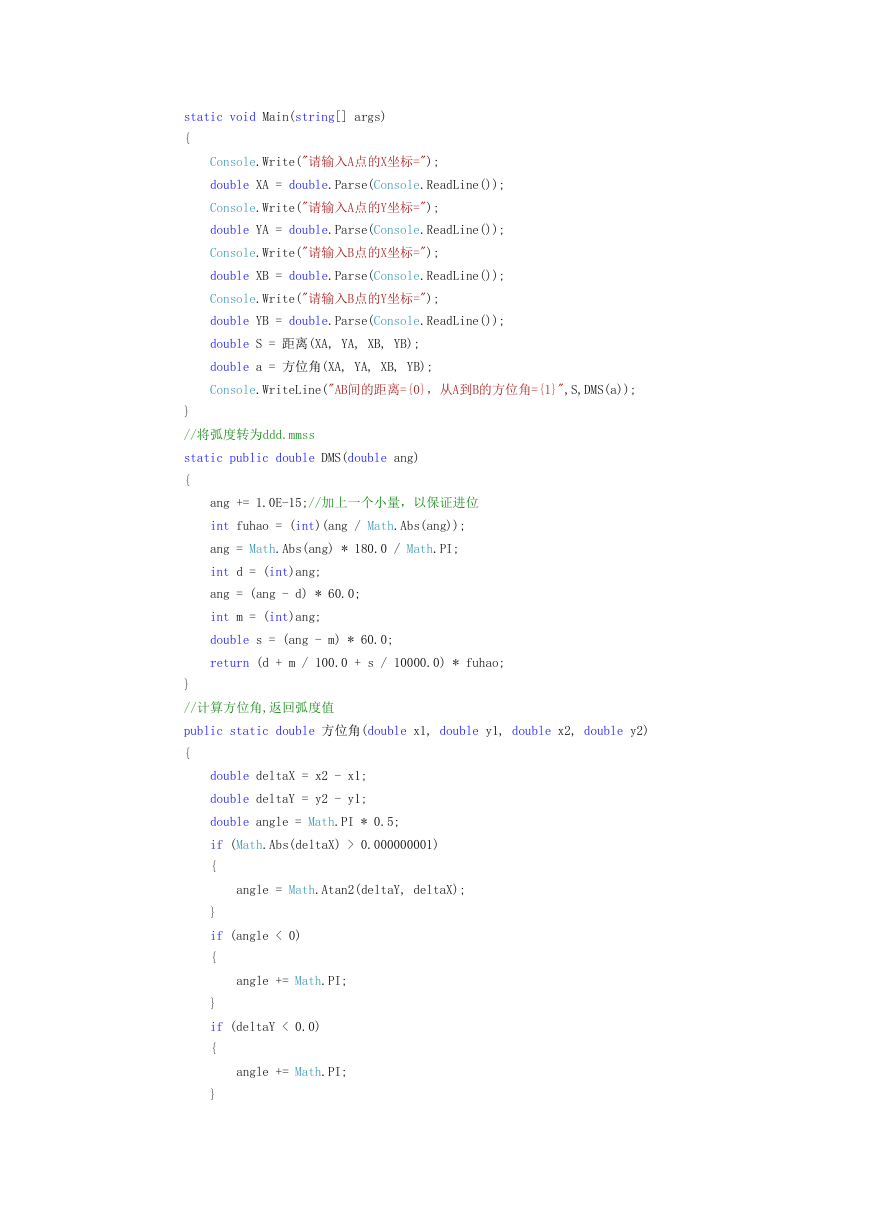
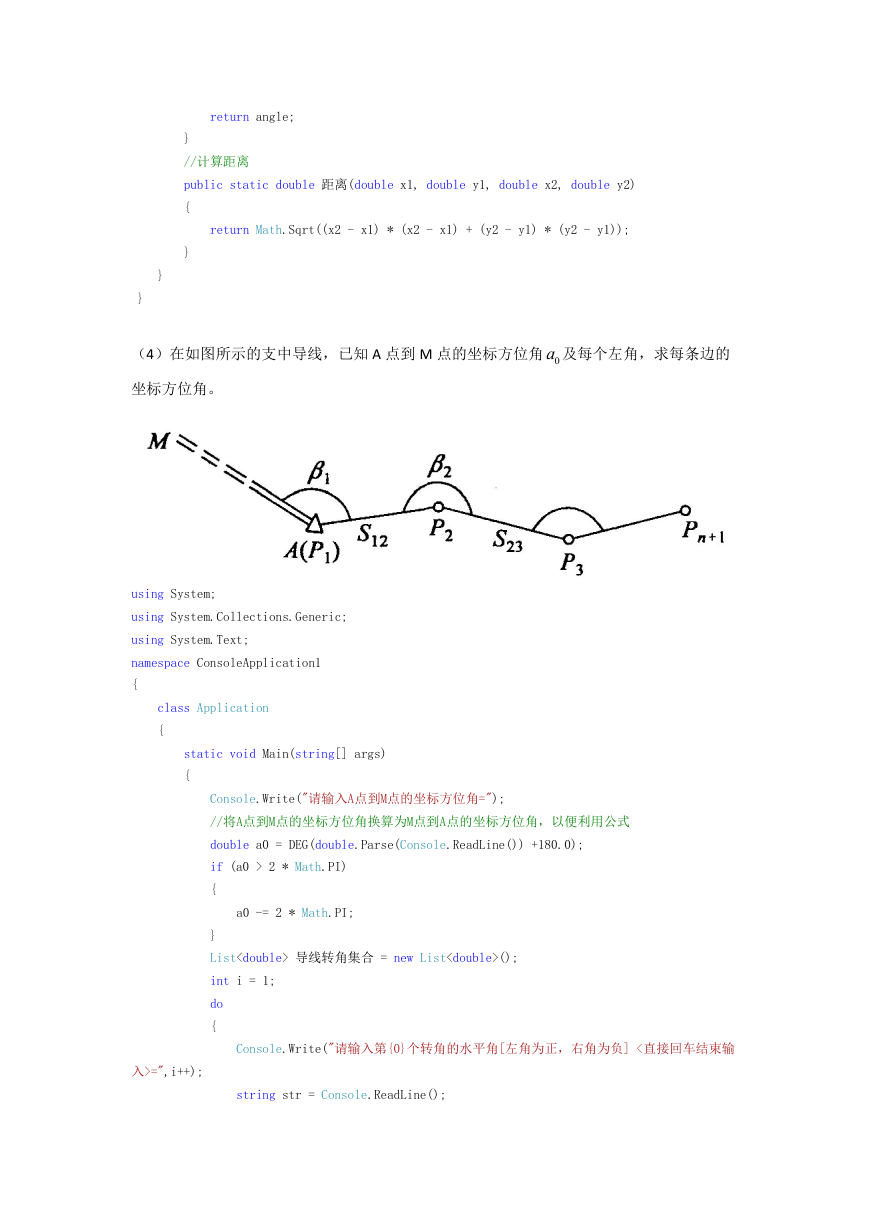
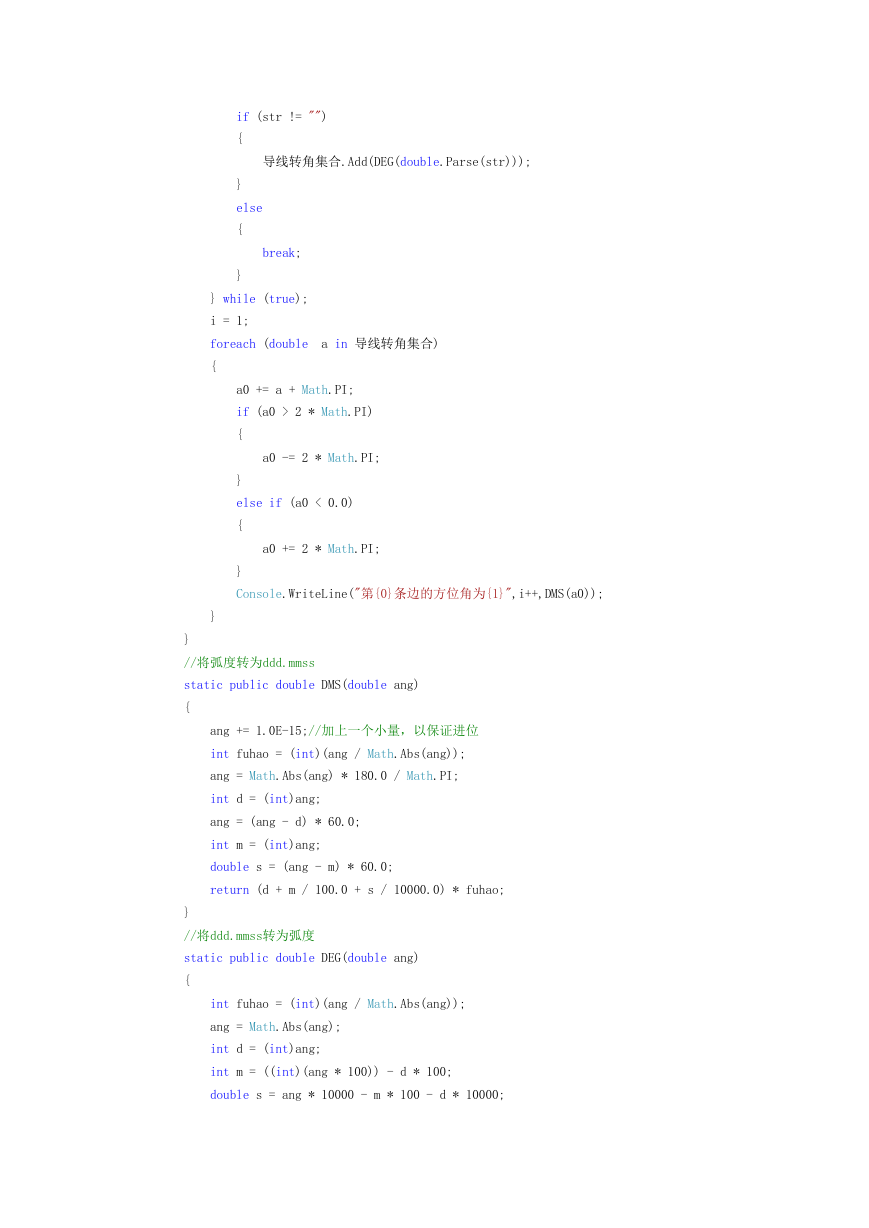
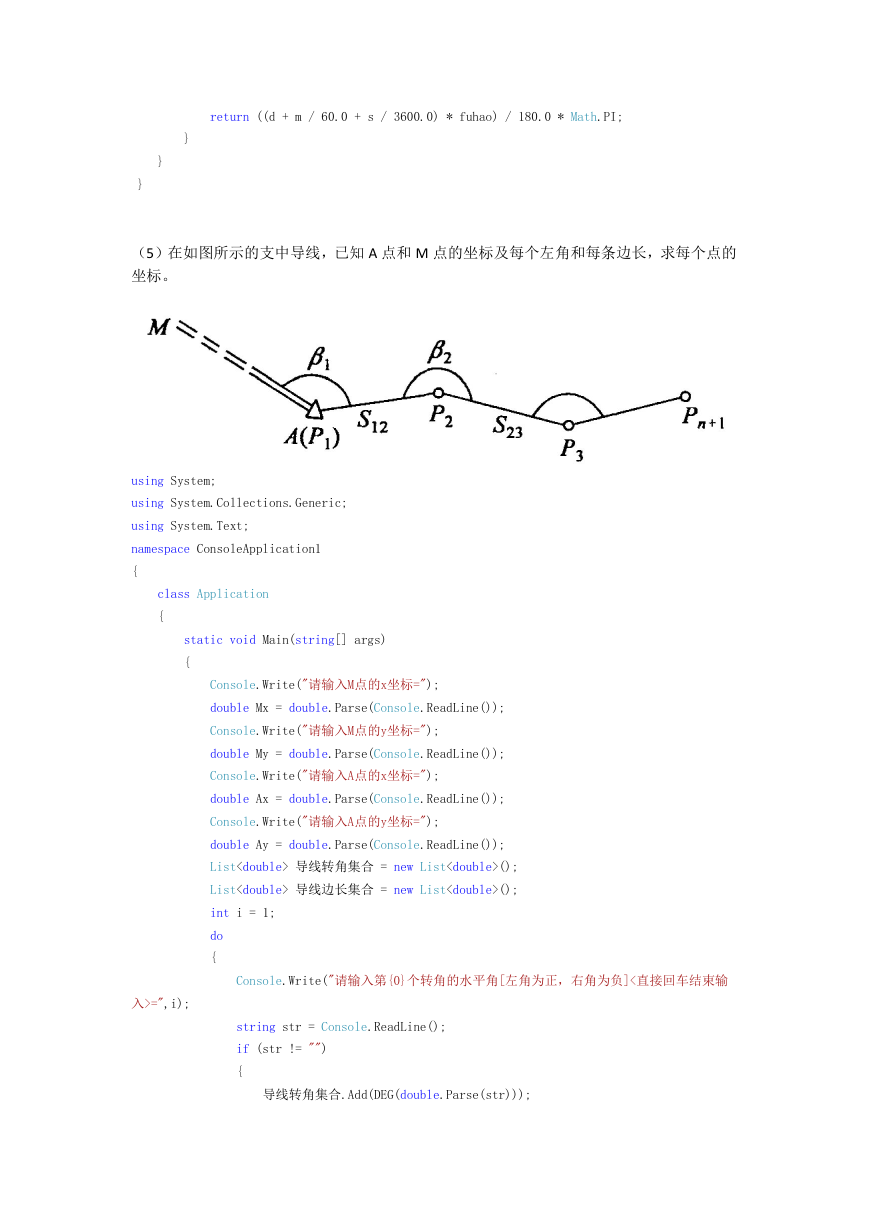
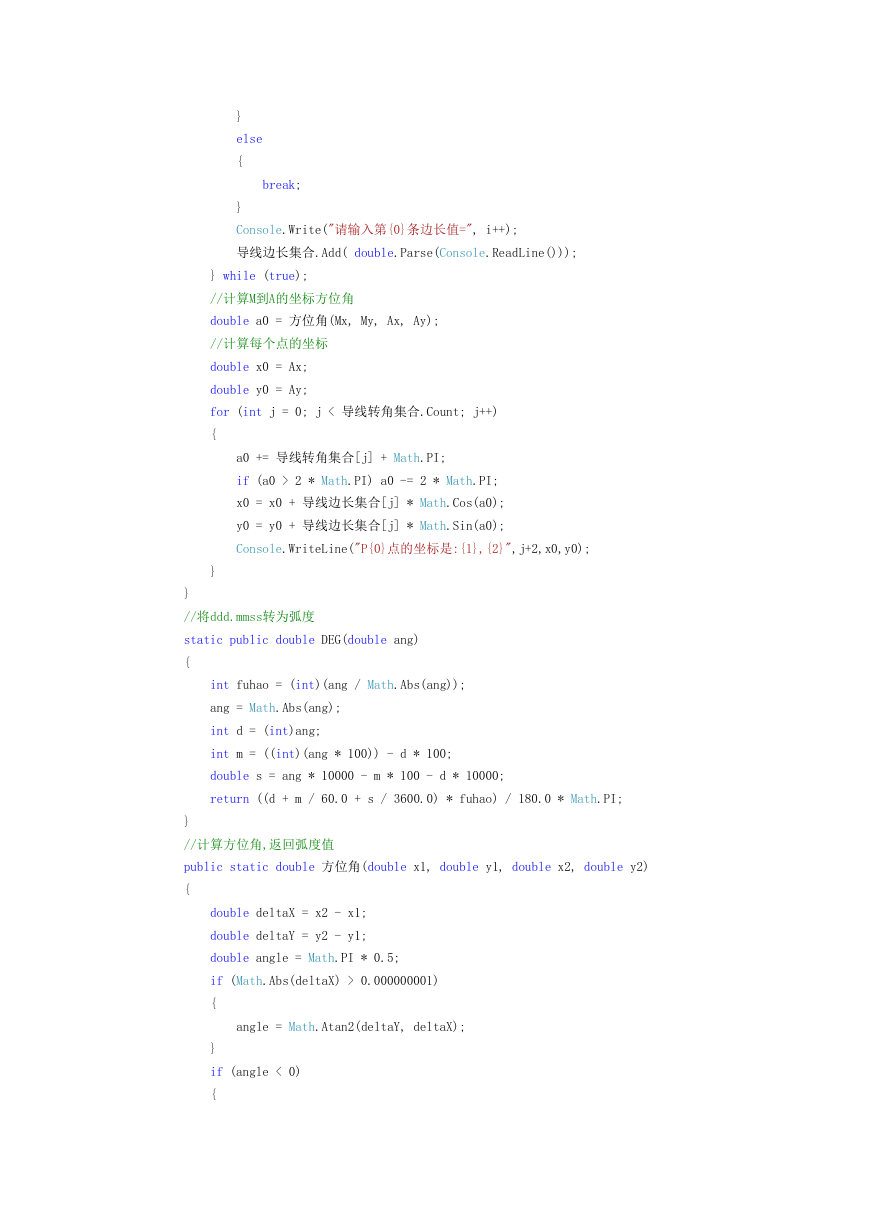
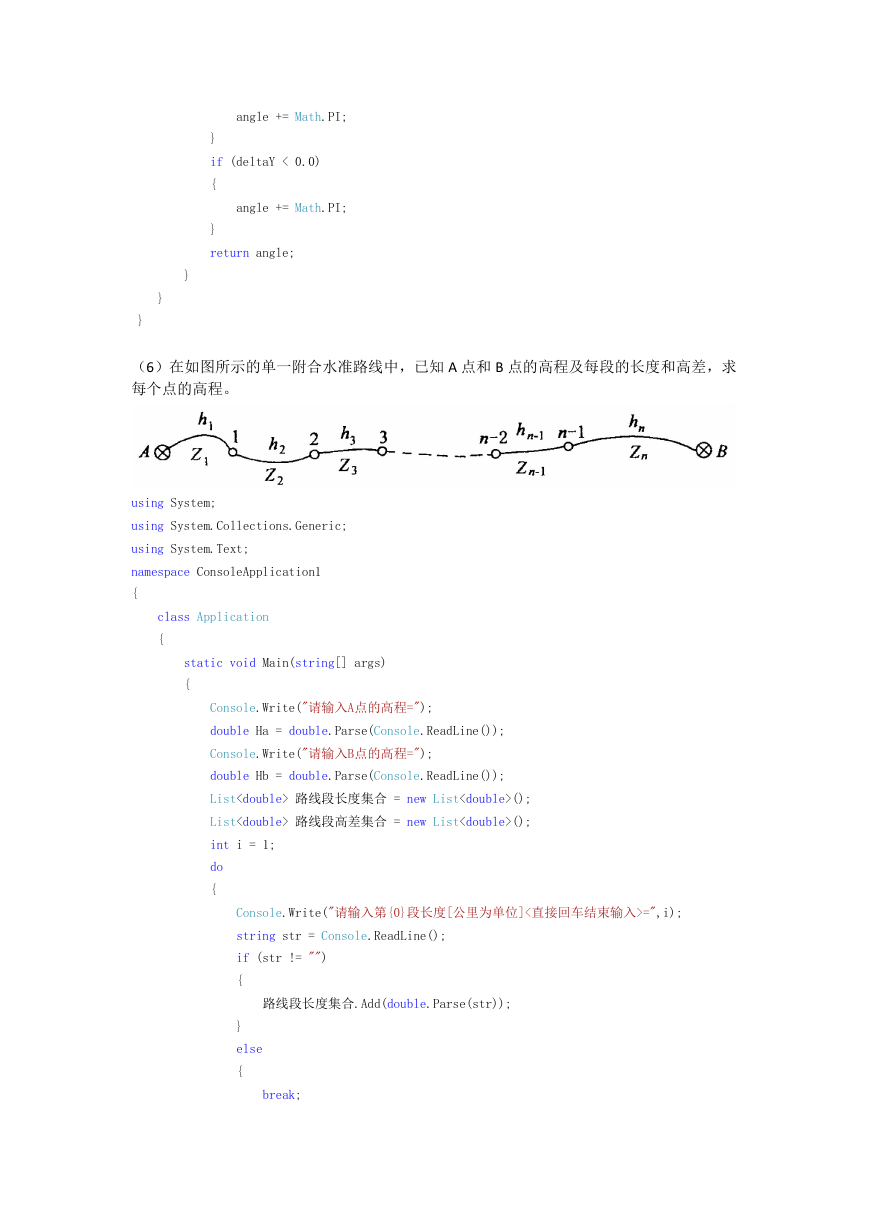








 2023年江西萍乡中考道德与法治真题及答案.doc
2023年江西萍乡中考道德与法治真题及答案.doc 2012年重庆南川中考生物真题及答案.doc
2012年重庆南川中考生物真题及答案.doc 2013年江西师范大学地理学综合及文艺理论基础考研真题.doc
2013年江西师范大学地理学综合及文艺理论基础考研真题.doc 2020年四川甘孜小升初语文真题及答案I卷.doc
2020年四川甘孜小升初语文真题及答案I卷.doc 2020年注册岩土工程师专业基础考试真题及答案.doc
2020年注册岩土工程师专业基础考试真题及答案.doc 2023-2024学年福建省厦门市九年级上学期数学月考试题及答案.doc
2023-2024学年福建省厦门市九年级上学期数学月考试题及答案.doc 2021-2022学年辽宁省沈阳市大东区九年级上学期语文期末试题及答案.doc
2021-2022学年辽宁省沈阳市大东区九年级上学期语文期末试题及答案.doc 2022-2023学年北京东城区初三第一学期物理期末试卷及答案.doc
2022-2023学年北京东城区初三第一学期物理期末试卷及答案.doc 2018上半年江西教师资格初中地理学科知识与教学能力真题及答案.doc
2018上半年江西教师资格初中地理学科知识与教学能力真题及答案.doc 2012年河北国家公务员申论考试真题及答案-省级.doc
2012年河北国家公务员申论考试真题及答案-省级.doc 2020-2021学年江苏省扬州市江都区邵樊片九年级上学期数学第一次质量检测试题及答案.doc
2020-2021学年江苏省扬州市江都区邵樊片九年级上学期数学第一次质量检测试题及答案.doc 2022下半年黑龙江教师资格证中学综合素质真题及答案.doc
2022下半年黑龙江教师资格证中学综合素质真题及答案.doc